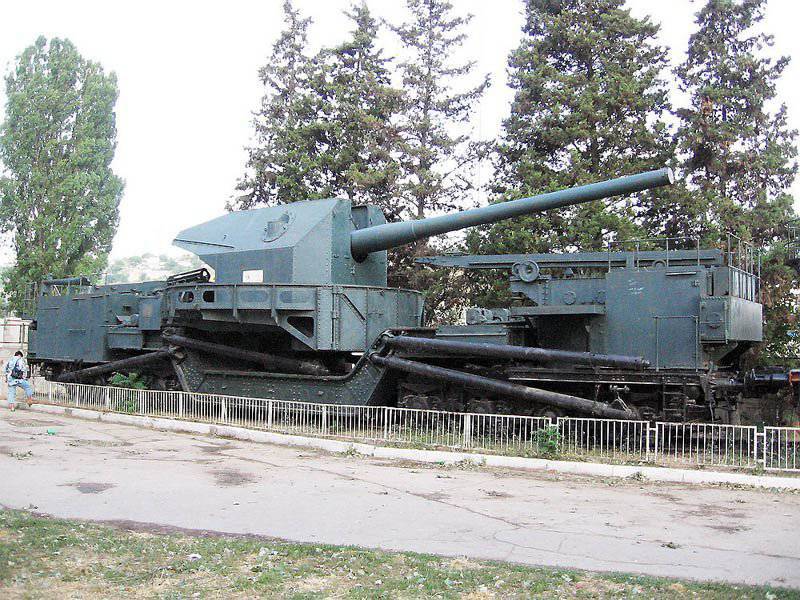Railway artillery of the Soviet Union

The production of the TM-1-180 railway platforms themselves was carried out by the Nikolaevsky plant No. XXUMX, and the B-198-P implements themselves were manufactured by the Barricades factory. The launch of the platform began in 1, the high-explosive fragmentation, semi-armor-piercing and armor-piercing shells, a grenade with a BM-1934 remote fuse, with an equal weight of 16 kilograms were included in the ammunition of the installations.
The main purpose of the artillery batteries on the railway platforms is the struggle and destruction of the enemy surface ships. At the beginning of World War II, the Gulf of Finland was completely covered by railroad batteries, three 356-mm batteries, three 305-mm batteries and eight 180-mm batteries. They supplemented the stationary naval artillery batteries caliber 152-mm and 305-mm. But since the Wehrmacht did not plan to seize the bay with the help of surface ships, the railway batteries were left idle.
In the early days of the war, it was not easy for the artillery rail batteries No. XXUMX and No. XXUMX, the Finnish troops blocked them on the Hanko peninsula. The batteries were used to fire at fortified Finnish positions and shelling Finnish Tammisaari. At the end of 17, when the Soviet troops left the peninsula, the batteries were destroyed, the 9-mm caliber barrels were blown up, the support legs were broken and sank along with the platforms.
But the Finns, nevertheless, restored the batteries, the platforms were pulled out of the water, the supporting legs were restored, the trunks were delivered from the battleship Alexander III through occupied Europe. The 305-mm caliber railway battery was put into operation, and 180-mm was not put into operation even after the armistice concluded with Finland in 1944, the USSR received back all the batteries. In the 1945 year, they joined the Soviet Armed Forces as batteries of a railway brigade.

May 5, 1936 is connected story the creation of new artillery installations of very large caliber, the Council of People's Commissars approved the decision on the creation of railway artillery of large and very large caliber.
In 1938, a technical assignment is issued for the production of TP-1 railway platforms with 356-mm caliber and TG-1-caliber guns with 500-mm caliber. According to the project "TP-1" was created with the aim of countering the linear surface ships and monitors of the enemy and for the use of batteries in ground operations with concrete complexes of the project "TM-1-14". "TG-1" was intended to be used only in ground operations.
Several dozen factories from all over the Soviet Union took part in the work to create these colossal battle rail batteries. Trunks on TP-1 and TG-1 installed lined, piston valves opened push-pull up, platforms were identical to TM-1-14. The speed of movement on railways to 50 km / h, there was the possibility of restructuring the movement of the railroad of the western type.
For the TG-1 with the 500-mm tool, there were two projectiles, an armor-piercing reinforced power (concrete) weighing 2 tons and having 200 kg explosive mixture and a high-explosive mixture weighing about one and a half tons and having an explosive mixture about 300 kg.
An armor-piercing projectile of enhanced power (concrete) pierced concrete walls with a thickness of up to 4,5 meters.

Long-range, high-explosive, armor-piercing and combined projectiles were provided for the TP-1 with a 356-caliber gun. High-explosive and armor-piercing were of the same weight - 750 kg and differed in the amount of explosive mixture. Long-range ammunition differed from the armor-piercing only by reduced weight - 495 kg, and, accordingly, range, 60 km versus 49 km.
Combined ammunition in 40 was considered sub-caliber ammunition, weighing 235 kg (the weight of the 127 kg projectile itself), and 120km.
The Soviet Union planned to build a total of 1942 guns on the railway platform of these projects before the end of 28, but due to the constant workload of the factories creating surface ships, only one TP-1 and one TG-1 were built. And after the start of the war, work on projects was interrupted.
Postwar years, the Soviet Union began designing new artillery complexes on railway platforms of various calibers.
Back in 43, the TsKB-19 designed an artillery system with a caliber of 406-mm. Project "TM-1-16" with a swinging node B-37. In 51, already “TsKB-34” using these developments, developed the project “CM-36”. In the project, for the first time, the system used a double rollback, the specialized PUS “B-30” and the radar “Redan-3”. Radar began to develop in 48 year, and it used a new indicator for the exact coordinates of the bursts from the shells hit. But at the end of 54, the project was stopped.
Termination of the development of artillery systems on railway platforms was of a political nature. General Secretary of the CPSU Central Committee N.S. Khrushchev brought the work on the creation of large artillery to naught.
But heavy artillery was still in service for a long time. fleet. At the beginning of 84, there were 13 units in the composition of the Navy of the Soviet Union. Eight TM-1-180 were part of the Black Sea Fleet, the naval base in Leningrad had three TM-1-180 and two TM-3-12.
Information